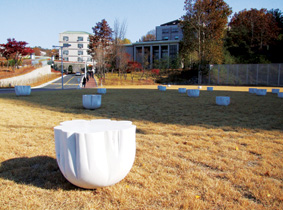Have you ever wondered what the numerous white rock-lookalike chairs placedirregularly on the empty grass next to the front gate are? You might have just passed by those ‘things’ without giving a second thought. Or you might havetried to sit on those chairs to chat with your friend, or to take a picture ofthe pretty artwork. But what are these chairs anyway? Here comes the shocking truth: they are art works displayed by the professor of Ewha. And here is something even more surprising; they mean more than just chairs, they are nature. 
The Department of Sculpture borrowed the empty space next to front gate to exhibit their professor’s artwork from November 10 to December 10. “We reserved theempty space under our professor’s request, and we are planning to hold similar exhibitions more often in the future,” said a staff member at the Department of Sculpture. The artist for white granite chairs is Professor Park Il-soon(Sculpture). “The chairs were made to suit its purpose, but I also had anotheridea in mind. I wanted to portray the beauty of the natural cycle. If you lookat the art work carefully, you may realize that the granite reflects the root ofthe trees. The surface of the granite shows the root slowly turning into blossoms,” said Park.
She went on to explain that the reason why the granite was placed irregularly was because the entire scene had to describe a forest where treeswere cut off. “I have a few more masterpieces exhibited around the school, such as the Pfeiffer Hall. All of my art works are related to life and nature,because I want the Ewha students to see the true beauty and power of nature.That is my career motto,” added Park.
But some students had no idea what these pieces were doing indifferent parts of the campus. “There were no name tags or whatsoever to indicate that the chairs were artworks. So I did not make a big deal when little kids were trying to sit on the chair and tourists were trying to touch them and take pictures. But I soon realized that they were artworks when the security guard came to tell the people that they are not allowed to touch or sit on thechair,” said Ko Jin-a (Design, 1).
According to a staff at Department of Sculpture, there are more exhibitions planned innear future. “Art works will be exhibited in exhibition hall this time and noton the empty grass. We are combining students’ and professors’ works for thegraduation exhibition. Everyone is welcomed,” said the staff member.
With more plans for holding exhibitions in the future, experts in the department related to design and sculpture strive to turn the campus into theirMeccaforpowerful and magnificent masterpieces. “Until the last day of my exhibition,which is December 10, I wish students and even people who are not Ewha students will see the cycle of nature by witnessing the roots blooming into flower blossoms.

